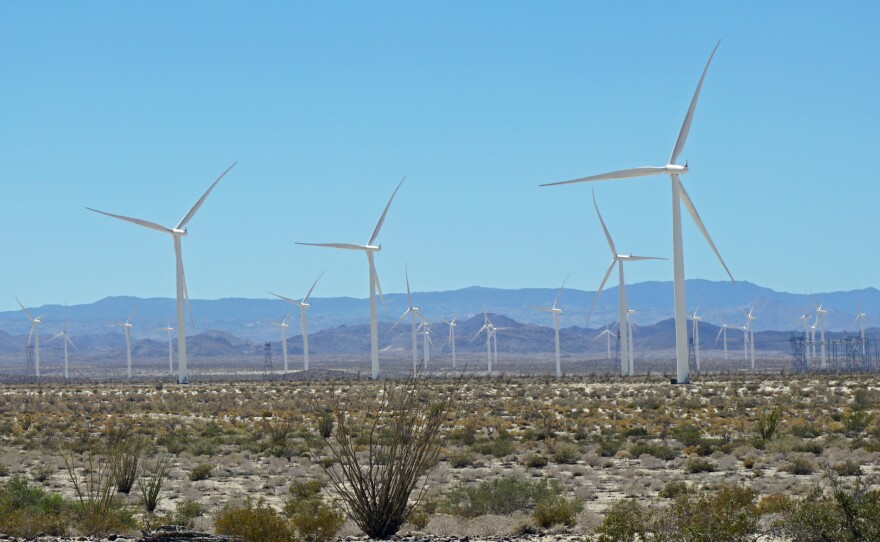San Diego Gas and Electric has said it is committed to delivering more than 40 percent of its energy from clean, renewable sources by 2018. Traditional energy companies maintain that more renewable energy sources like wind and solar cause problems for the electrical grid.
That no longer has to be the case, according to an executive of Sempra Energy, the parent company of SDG&E.
Speaking Thursday night at UC San Diego's Institute of the America's annual energy conference, Sempra Vice President Patrick Lee said the technology exists today for a total reliance on renewable energy.
“If you were to ask me three years ago, you know as a power engineer, can we actually achieve a high percentage of renewable, my answer was probably ‘no.’ I’d say, ‘we’re going to need some base load generation,'" Lee said. "But today, my answer is, the technology has been resolved. How fast do you want to get 100 percent? That can be done today."
inewsource reporter Ingrid Lobet attended the conference and she spoke with KPBS Midday Edition host Maureen Cavanaugh. Below is their conversation, lightly edited for clarity.
Q: That is a bit of blockbuster comment coming from a Sempra executive.
A: It really is. This is not the head of the Solar Energy Industries Association saying this. This is not the head of solely wind company saying this. This is a vice president of a major investor-owned utility saying we can get to 100 percent renewable now.
Q: Is he talking about new batteries that can store power from solar and wind?
A: It’s certainly batteries, and there are other kinds of storage also, there are ways that you can store energy with water by pumping it uphill or behind a dams, so yes it is storage. But it's not just storage. You have to have a way to — let's say we're getting — at any given moment, 60 percent of our electricity on the grid from solar, and a cloud passes over. You need something that is going to be able to dispatch that stored energy immediately. You cannot be relying on a human being to say, “Oh look, we’re out of energy.” You cannot have a pause. And so what I think he is really referring to are breakthroughs in the technology to control stored energy.
Patrick Lee also said the decision about renewables is now more about economics than technology.
Lee said, “I’m speaking with confidence that we have a solution now. We have you know the adjusted intermittency of solar and wind energy that is no longer a technology challenge. Now it’s really an economic decision whether you are in Ireland or in the Americas. So installing baseload power plant is no longer your only option. You can now look at, you know, solar, wind and storage as alternatives, and it’s still able to manage the reliability of the grid.”
Q: What did he mean?
A: I think what he means is that any given company would still have hundreds of millions or billions of dollars invested in assets which still have many years of useful life, and which they are still planning on receiving an economic return on. And you can't just abandon them or you certainly have to think very carefully at what pace you’re going to switch away from them.
Q: Sempra is the parent company of San Diego Gas and Electric, and SDG&E has made the case that we need new fossil fuel plants, like the peaker plant being built in Carlsbad, at least in part because we can't rely entirely on renewable energy. Are Patrick Lee's comments a contradiction to that argument?
A: I think in a way they are. They certainly raise questions about some of the other things we've heard from Sempra and from the builder of that plant, NRG, that we are just not quite there yet. Here we have the vice president Patrick Lee saying, "actually we are there."
Q: How is Sempra making this move toward selling the idea of 100 percent, or high percentages, of renewable energy?
A: Well, I think in your lead you mentioned the goal of 40 percent. In fact, I believe Sempra is out in front of that. They have told me that they delivered 43 percent renewable energy in 2016. We have not seen the breakdown of that yet, but I believe they are already ahead of schedule. And, Patrick Lee is the president of a new Sempra company called PXiSE energy solutions, which apparently exists to sell the new technology that it has developed. It has some of its own patents pending, and it has seven patents that it has licensed that were developed in partnership with UC San Diego and with a company called OSIsoft.








